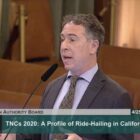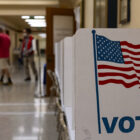A community-funded report originally published on Spot.us
| Passengers board a 16AX-Noriega express bus on Eddy Street for the evening commute to the outer Sunset District. The 16AX is among the express routes proposed for expansion. |
For years, a lack of information left Muni in the dark about what it was doing well, what it had to improve and what its riders actually needed. But a proposed shuffling of resources following the Transit Effectiveness Project, a massive systemwide study, would add more frequent service and extend routes on some express lines serving city commuters.
Even from a distance, it’s clear that something’s different about this Muni bus stop. Instead of a disorganized clump of people standing around near the intersection of Fifth, Cyril Magnin and Eddy streets, there’s an orderly, quiet queue, and quite a large one. More than two dozen people, many clutching umbrellas or wearing raincoats, though the morning’s rain has passed, gather just after 5 p.m., chatting with each other, sending text messages or checking their watches. Someone new arrives, briefcase slung over his shoulder, and takes his place at the end of the line.
Then a diesel bus rumbles around the corner of Eddy Street and pulls up to the head of the queue of waiting people. They all file on quickly and in order – with none of the pushing and jostling common when boarding other Muni buses and trains. Once everyone in the line is on board, though, the driver doesn’t close the door. Instead, he checks his watch and waits. After a few more passengers run up to the bus and climb inside, the driver checks his watch again, shuts the door and pulls away from the stop, the 16BX-Noriega embarking on a nearly direct 40-minute journey across town to the outer Sunset District.
This is San Francisco’s Muni express-bus service in action, and for thousands of riders who need to travel between home in the city’s residential neighborhoods and jobs downtown, riding an express is a dependable daily ritual.
But if the service is so popular and moves passengers with such seeming efficiency, why doesn’t Muni run more express buses?
Lack of information
Part of the reason Muni doesn’t run more expresses is that it wasn’t sure anyone wanted them. Until recently, it had been many years since the transit agency carefully examined whether its level of service was in line with what its riders needed.
“They haven’t been a real market-research-driven organization in the past,” noted Tom Radulovich, a member of the BART Board of Directors and the executive director of Livable City, a San Francisco nonprofit organization that advocates for better transportation systems.
Dave Snyder, director of transportation policy at the San Francisco Planning and Urban Research Association think tank, which has been analyzing Muni and pushing for improvements, agreed: “They haven’t had the opportunity to adjust their service to meet demand for a couple of decades.”
“This was a mistake on their part not to have done more evaluation," Snyder said.
Hidden costs
Julie Kirschbaum, manager of Muni’s Transit Effectiveness Project, says there also are other reasons why Muni doesn’t run more expresses. One is that although they might seem to be highly efficient – buses fill to capacity and swiftly transport full loads of passengers all the way across town with a minimum number of stops – there are some hidden costs to express service.
One of those hidden costs is that express buses only gather revenue for Muni in one direction. In the morning, a bus may be full going downtown, but on the return trip to pick up more morning commuters, it travels empty. A local-service bus, on the other hand, may go through the equivalent of three or four full loads of passengers over the length of a similar route, as riders get on and off. Another important consideration for Muni, which often has been criticized as having high labor costs and inefficient scheduling and management of its workers, is that each driver assigned to work on a given day is guaranteed a minimum of eight hours of work, with a daily maximum of 12 hours.
But the span between the start of morning express service and the end of evening express service is more than 12 hours. This means, said Kirschbaum, “you would typically need two operators … to drive one express route.”
Study prompts changes for expresses
But the San Francisco Municipal Transit Agency, the body that oversees Muni, last year concluded the Transit Effectiveness Project, an exhaustive examination of its service, rider demand and opportunities to improve service or make it more efficient. Among the findings of the TEP was that some of the express lines should add stops, adjust their routes or institute more frequent service.
“We’re proposing starting increases in express service on our busiest routes. We want to continue to deliver a high level of service to our existing express customers,” said TEP manager Kirschbaum.
Muni even considered whether the fact that many office workers now have flexible hours meant that express service should start earlier and run later. The answer is that although some changes are warranted, they’re limited in scale.
Radulovich says that although more commuters are traveling on the “shoulders” or edges of traditional commute times, most transit agencies still serve most of their commute riders in strongly concentrated morning and evening peak periods.
“In the Transit Effectiveness Project, we evaluated that route by route,” said Kirshbaum. “If the last trip was well used, that was a signal to us that there was probably a market” for more runs. Accordingly, the TEP calls for modest adjustments in the start or end times for some express service, and more frequent buses on some other lines. In some cases, proposals would reduce service in either the morning or evening, but increase it at the opposite end of the day.
Among the more significant expansions the TEP proposes for express routes would come on the 16AX and 16BX – but not by making buses arrive more frequently. These routes now travel between the outer Sunset District – mostly along Noriega Street – and the area near the Powell Muni/BART station. But the TEP found that large numbers of people traveled every day from the Sunset District to downtown, and more of these people might use the Noriega express buses if they went all the way to the Financial District.
“One of the things we’re talking about is extending those routes to downtown to capture the market that isn’t on those buses,” said Kirschbaum. The TEP proposes extending both the 16AX and 16 BX further into the downtown job core, to Market and Spear streets.
Optimism despite anemic budget
Shrinking transit funding from the State of California and the City of San Francisco – as well as the federal government’s preference for funding buildings and equipment, rather than operating costs – will have an effect on Muni, including potential hits to vehicle maintenance, which would reduce Muni’s reliability systemwide.
And budget problems will have an impact on the TEP. “We do expect the budget challenges to slow the implementation of the TEP,” says Muni spokesman Judson True.
In 2008, an idea emerged to charge riders who pay cash fares an extra dollar to board express buses, but the proposal petered out. True said there’s still a chance the SFMTA might decide to pursue an express-bus surcharge again.
“Once an idea is out there it never really goes away. … It’s still out there as an idea,” said True.
In fact, the SFMTA Board is scheduled to discuss its budget for the coming fiscal year at a meeting Tuesday morning, March 17 — including the possibility of raising express cash fares. According to documents prepared for the meeting, Muni could gather an additional $1.4 million by raising the fare for all cash-paying express riders by $1.
Either way, because the TEP is focused on ways of doing business and on redirecting existing resources, Kirschbaum says she thinks the TEP’s recommendations for improved express service will remain largely intact: “Because the TEP service plans are resource-neutral, we’re still looking forward to implementing the TEP route proposals.”
What about crowding?
One of the common complaints of express riders, like other Muni riders, is crowding. Do crowded buses indicate a problem, or is crowding just a fact of life for public transit in a dense city?
Dave Snyder, transportation policy director at the civic think tank the San Francisco Planning and Urban Research Association, says crowding on cross-town vehicles could be driving away people who might otherwise want to use public transit.
“It’s a problem,” said Snyder. “Standing-room-only buses say that more people would take the bus if they could get a seat. … It’s a sign of success that there’s demand for the bus, but there’s more people [who would take it if it were not so crowded].
“Standing on buses for short trips is OK, but any time people are going to be on for 15 minutes or longer, people want to be able – and should be able to – sit and read a book.”
Other transit advocates agreed that bumpy rides and crowded vehicles are easier to tolerate for people only traveling a few blocks than for cross-town commuters.
“For someone standing 40 minutes, 50 minutes as you go across town, that’s real taxing,” said Tom Radulovich, a member of the BART Board of Directors who also heads up the transit-boosting nonprofit organization Livable City.
Radulovich said that crowded buses are a particularly important issue for Muni riders, who may be on the bus for as long as some interurban rail commuters, but ride vehicles that are designed only for short trips.
“In some ways, Muni riders get the worst of both worlds,” said Radulovich.
However, Julie Kirschbaum, the manager of the Transit Effectiveness Project at the San Francisco Municipal Transportation Agency, disputes the idea that very full vehicles are bad, and says that Muni isn’t in the business of cushy transportation.
“The Muni system is designed for all seating customers, plus standees,” she said. “We don’t have a system that’s designed for everyone to get a seat.”
Kirschbaum said transit industry experts don’t necessarily agree that crowding is a problem. Furthermore, she said, since express buses only carry paying riders in the peak travel direction – toward downtown in the morning, for instance – they need to carry a full load.
“We strive to have all of our buses full but not crowded,” she said. “Express buses in particular should be full of customers.”
Muni express buses by the numbers
. Number of routes: 16
. Number of routes offering all-day service: 1 (9X-Bayshore)
. Typical minutes between buses: 10
. Express riders as percentage of total Muni riders: 4.5
. Average number of passenger boardings per weekday on all express lines: 29,200
Sources: SFTEP Draft Proposals Report Cards (data based on FY06/07 cost information and ridership collected by automatic passenger counts); SFTEP Service Evaluation (October 2007).
NOTE ON THE NUMBERS: The average daily passenger boardings figure doesn’t necessarily mean that 29,200 different people ride expresses every day. The same person may be counted once headed downtown in the morning and once headed back out in the evening (or may not be counted in one of those directions at all, if he or she travels by any method other than one of the express buses).








